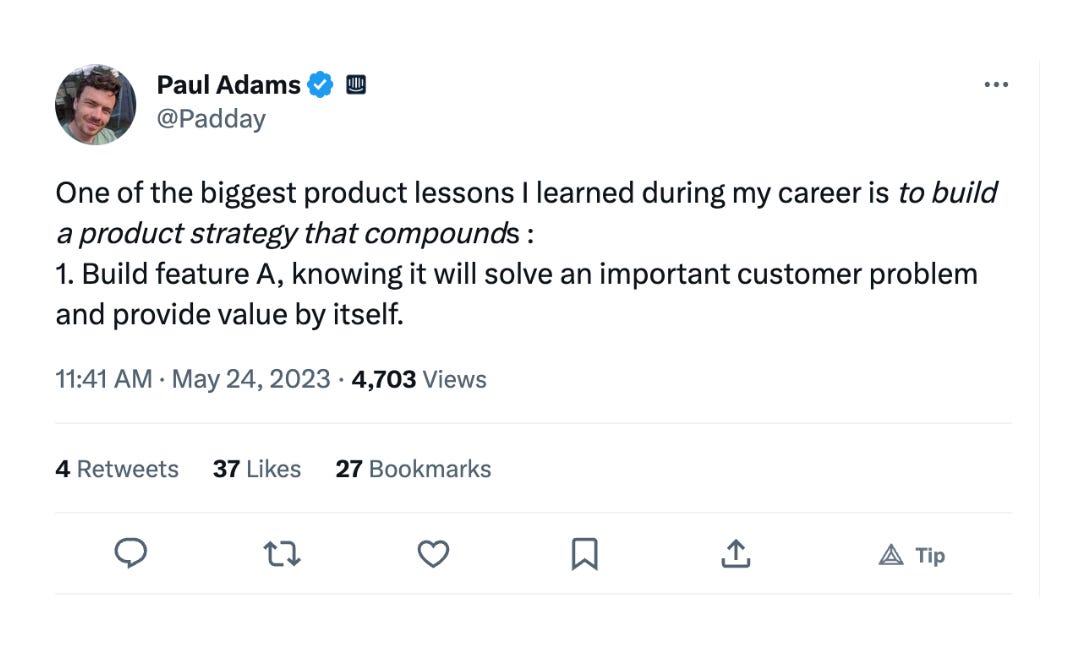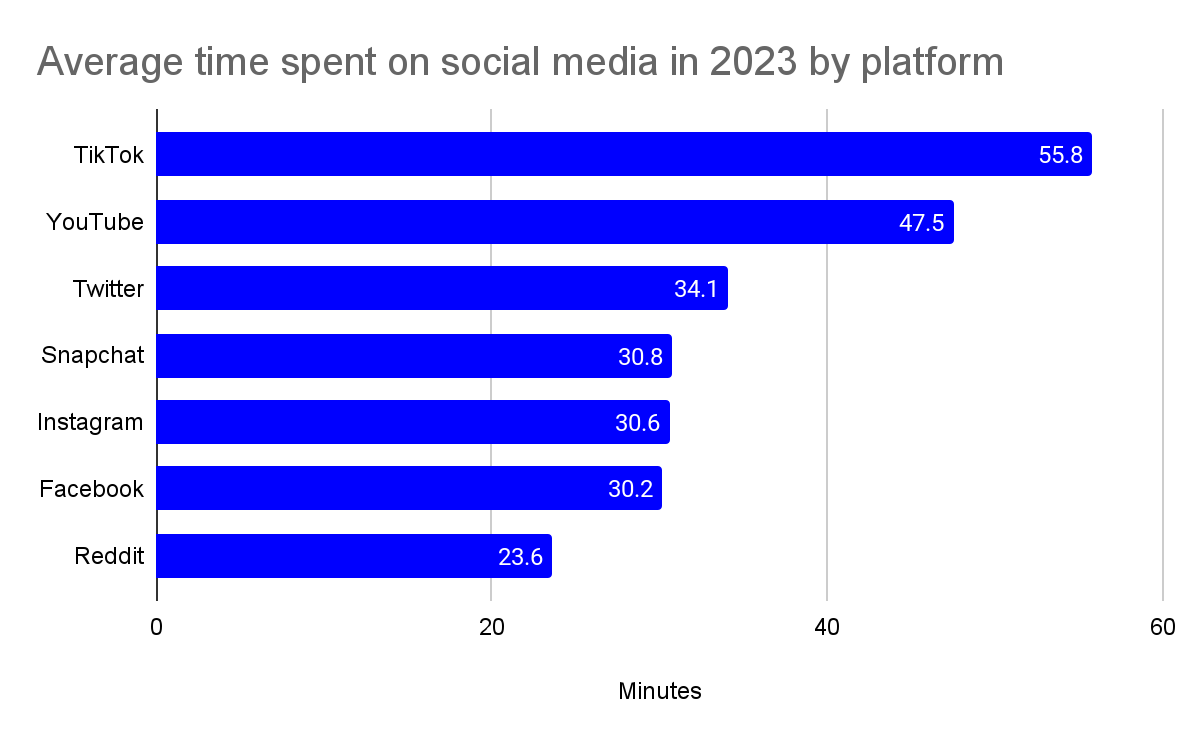The Department of Product
Briefing
Adobe unleashes its superpower and NYT takes on Spotify Plus: a new tool to Rewind your life, Google Docs plays Notion catch up and Coinbase impresses
Hi product people 👋,
Does the idea of recording everything you do on your laptop each day freak you out a little? When I first heard about Rewind, my initial reaction was ‘hmm… that sounds a little suspicious’. But upon closer inspection, I understood why something that records every action might actually be pretty valuable, for some people at least.
If you’ve not heard of it before, Rewind is a product that creates a searchable history of your Zoom calls, Slack conversations, Google Docs and everything in between. And this week, the company jumped on the AI bandwagon with the release of a new feature called Ask Rewind which allows you to ask questions about your own activity. For example, you can ask it what you were doing last Tuesday or to look up a history of some key terms before an important call. It certainly sounds interesting, but a question mark remains over whether this use case is indeed useful and how much more useful conversational interfaces are over bog standard buttons. You can check out a video of it in action here.
Other products on our radar this week include Nudge. Designed to help product teams embed gamification into user journeys, Nudge is essentially gamification as a service. Users can choose from gamification design patterns including point systems, milestone-based challenges and streaks. Streaks have proved wildly successful in driving engagement for many product companies, including DuoLingo, so it’ll be interesting to see if Nudge can carve out a market for itself here.
Not to be outdone by plucky startups, Adobe flexed its product muscle this week, too, with the release of a new feature that showcases why it’s still a formidable creative force worth $170 billion. The company previously announced the release of Firefly, its generative AI feature, a few weeks back. But now it’s shown what it can do inside Photoshop. Described as a “superpower” by chief product officer
, Generative Fill can add new elements to backgrounds and generate context-specific assets to ‘fill in the gaps’ at the touch of a few buttons. Whilst some believe this signals the beginning of the end for designers, others take a more nuanced position, suggesting this is akin to the development of Excel for finance workers. Design teams will no doubt still be nervous, though. The prospect of non-designers opening up Photoshop and getting it to create stuff just to prove how “easy” design is, is of course, thoroughly terrifying.
Finally, if you’re interested in exploring how APIs can fit into your wider product strategy, we’re co-hosting a free webinar on API product strategy with Square’s Lead PM and you can register here.
Enjoy the rest of your week!

Essential reads for product teams
UX strategy – How UX can help drive product led growth
UX is crucial for a successful adoption of the product-led growth model. The user’s very first experience with the product is critical. If users do not understand the product’s value quickly, they are likely to move on to the next similar product offering. (NN Group)
Strategy – Why early hype leads to mediocre product outcomes
Hype is good for innovation: it attracts capital, draws talent, and raises awareness from prospective customers. But inevitably expectations get out of touch with reality and the hype bursts. What happens next depends on user adoption or, put differently, the technology finding product market fit. (
)
Tools you can use
-
UX writing assistant – improve your product’s UX copy
-
PiP – add picture in picture mode to any window on your Mac
-
Word Mentor – expand your vocabulary and elevate your comms
Tweet
Intercom’s chief product officer Paul Adams on the power of compounding product strategy:

Podcast – Spotify’s chief product officer Gustav Söderström
Gustav Söderström is the Co-President and Chief Product and Technology Officer at Spotify. He is responsible for Spotify’s global product and technology strategy, overseeing the product, design, data, and engineering teams. (
)
Design case study – How Google Material Design reinvented the carousel
A carousel component is a rotating array of content that allows users to scroll horizontally to view a list of items that aren’t immediately visible on the screen–for example, recipes, videos, and news. (Google Material Design)
New product features, launches and announcements this week
The New York Times has launched a new audio app after a beta period which lasted a year and a half. But, as Spotify recently discovered, difficult questions remain about the strategic benefits of a standalone podcast app; even when you’re blessed with the advantage of exclusive content, self imposed limits on distribution can hinder engagement and growth.
Google Docs launches collapsible headings – a feature widely used in competitors Notion and Coda – as the company slowly catches up with its rivals.
Every third Thursday of May, the world marks Global Accessibility Awareness Day. Major tech companies have unveiled their latest accessibility-focused products. Here’s a selection worth noting:
-
Apple is introducing Point and Speak – allowing a person to point to a word and get an explanation using the iPhone and iPad’s cameras
-
Netflix is introducing customisable subtitles to change text sizes, fonts and colors.
-
Adobe is launching a feature which automates the process of generating tags for PDFs to make them friendly for screen readers.
Microsoft has announced Windows Copilot – a personal assistant for Windows. Using the same underlying technology that’s used in Github Copilot and across Office, the new feature is pitched as a smart assistant that can do things like adjust settings or summarise content you’re viewing in apps. Are we close to smart assistant saturation point yet?
Peloton is relaunching itself as a general fitness brand, with a set of new pricing tiers and packages to match.
Product insights and trends to stay informed
TikTok is crushing all other major social media platforms with an average daily engagement rate of 56 minutes. The US Surgeon General is warning in a new report that social media could pose significant harms to young people. Full report here.

Instacart is on track to capture 73% of US digital grocery sales in 2023. Uber is projected to grow from 7.2% to 7.9%. Instacart’s ad revenue was $730 million last year, 30% of its net.
QR code payments are tripling every year in Indonesia and a new partnership between Indonesia, Malaysia, Thailand, Singapore and the Philippines could see 85% of Southeast Asia’s economy adopting the QR code payment system.
The average churn rate for TV streaming subscriptions is 5.8% with Netflix at 3.4% and Apple TV+ at 7.1%
Coinbase’s subscription revenue rose 138% to $361 million in Q1 2023 and overall subscription and services revenues grew 17x. This week, the company unveiled the launch of Coinbase One – a new subscription service. Full earnings report.
YouTube premium services are now generating $10 billion a year.
Amazon is struggling to retain tech talent with RSU stock forfeiture rates as high as 27% vs 8% for other big tech firms.
Other industry news in brief
Banking app Revolut’s finance chief has quit the firm for personal reasons.
Private search engine Neeva is closing, citing a failure to convince users to switch search engines as a bigger hurdle than paying for one.
LGBTQ neobank Daylight is closing, the CEO confirms.
Recommended newsletters
Top strategies and tactics used by fast-growing startups. For free. Once a week. Trusted by over 70,000 founders, product people and marketers.
Join 300,000+ professionals and get the data, anecdotes and visuals you need to understand today’s world and take your office small talk to the next level.

Product Briefing – November 16, 2023
Notion Q&A, Amazon Maps and Hallucination rates
Plus: WhatsApp expands, SaaS product benchmarks, Gmail transforms email, how to assess a job offer with equity
Product Briefing – October 26, 2023
Discord monetization strategies, Slack ditches X, Spotify growth
Plus: 50+ product analytics tools, Microsoft impresses, Google Meet gets appearance enhancers
Product Briefing – October 5, 2023
Google Docs’ new competitor, AI wars, App industry benchmarks
Plus: Airbnb’s ML patent, DoorDash’s swipe for restaurants and Uber expands to returns
Product Briefing – September 14, 2023
Uber’s secret task rabbit and DuoLingo’s new Music app
Plus: Retool AI, permissions simplified, Meta’s powerful new LLM
Product Briefing – November 9, 2023
GPTs for everything, Google Maps gets Immersive, Netflix’s QR codes
Plus: Slack’s CEO exits, How to use conjoint analysis, a new tool for reading API documentation
Product Briefing – October 19, 2023
Netflix’s $8 billion quarter, Figma in limbo, Synthetic UX research. Plus: YouTube’s major release, a new way to manage your calendar, the Web Technologies Report 2023
Product Briefing – September 28, 2023
Spotify’s voice clones, Apple’s new patent, surge pricing surges
Plus: Snapchat’s subscriber milestone, a GA4 alternative, DALL-E 3
Product Briefing – November 2, 2023
Google Slides’ superpowers, a Sublime second brain, Pinterest’s PMF
Plus: Tech salary report, how to manage API integrations, Spotify, Instagram and LinkedIn MAUs in context
Product Briefing – October 12, 2023
Freemium fallacies, Shopify AR, Space OS. Plus: Instagram Threads says no to news, Spotify on managing 500+ squads, Dropbox’s CEO defends remote work
Product Briefing – September 21, 2023
Google Bard Extensions and TimeOS
Plus: Slides gets indicators, WhatsApp payments expand, Fitbit’s makeover
